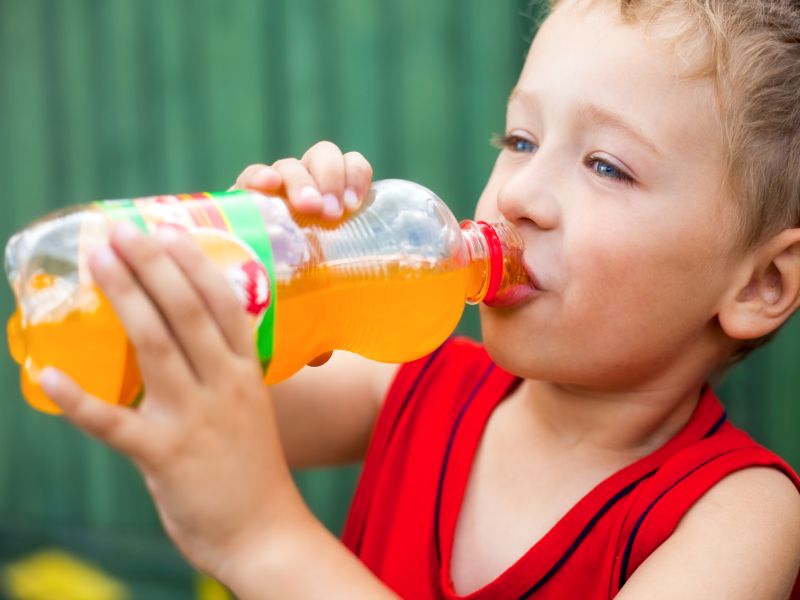Get Healthy!

- Posted October 16, 2019
None of Top-Selling Kids' Drinks Meet Experts' Health Recommendations
Drinks marketed to children often contain loads of unhealthy sugars and sweeteners, and they come in packages that deliver too-large servings, a new report finds.
None of 34 sweetened drinks aimed at the youth market meet nutrition recommendations of the American Academy of Pediatrics (AAP), according to University of Connecticut researchers.
"Sweetened drinks are about two-thirds of children's drink sales, compared to 100% juice-and-water blends," said lead researcher Jennifer Harris, director of marketing initiatives for the university's Rudd Center for Food Policy and Obesity in Hartford. "Parents may be surprised to know that pediatricians, dentists and other nutrition experts recommend against serving any of these drinks to children."
Sweetened drinks have been identified as a major source of excess calories for kids.
Added sugars account for 17% of the total caloric intake of children and teens, and sugary beverages contribute almost half of those added sugars, according to AAP.
For this study, Harris and her team looked only at products marketed for children, ignoring sodas, sports drinks and iced teas that are promoted for a wider audience.
They identified 67 products from 23 drink brands. About half contained added sweeteners; the others didn't.
The sweetened drinks made up 62% of the $2.2 billion in children's drink sales in 2018, researchers said. Pure juice or juice/water blends accounted for 38% of sales.
One serving of many of the highest-selling fruit drink brands -- Capri Sun, Hawaiian Punch, Sunny D and Minute Maid Lemonade -- had more than 50% of the recommended amount of daily added sugars for kids, researchers said.
Two-thirds of sweetened fruit drinks and flavored waters contained no fruit juice at all, the report said. Most that did have some fruit juice contained just 5%.
Even ostensibly healthier 100% fruit juice came in packaging that made the drink potentially unhealthy to kids, researchers found.
The AAP has recommended that 1- to 3-year-olds have at most 4 ounces of pure fruit juice per day, and older preschoolers, no more than 6 ounces.
"They don't need juice, but if they're going to drink it, they should drink it in limited amounts," Harris said.
But most single-serving 100% juice boxes and pouches contain more than 4 ounces, exceeding the recommended daily amount for toddlers, researchers found.
And some juice boxes and pouches even exceeded the 6-ounce serving recommended for preschoolers.
"We found a very small number of products that would be appropriate for a child under 3," Harris said. "Most of the juice boxes and pouches are bigger than a toddler should be drinking."
Experts recommend that children over a year old drink only plain water or milk, she said.
"They don't need any other kind of drinks," Harris said. "If you're going to give them juice, look for 100% juice in small servings."
Packaging often confuses rather than enlightens. Brands offering both sweetened drinks and drinks without added sweeteners often used similar-looking packages, flavor names and fruit images, researchers said.
For example, about 85% of sweetened drinks contained images of fruit on their packaging, but only 35% contained any juice at all, researchers said.
Parents have to look closely to figure out exactly what a drink contains, Harris said.
"You can't trust the front of the packages to know what's inside the drinks," she said. "You have to look at the Nutrition Facts panel to see what ingredients are in there."
Sweetened drinks are marketed heavily to children, the researchers also found.
Children between 2 and 11 see more than twice as many ads for sweetened drinks as for healthier alternatives, researchers said. These kids also see four times as many ads for sweetened drinks than their parents do.
The American Beverage Association (ABA) responded to the study in a statement.
"America's beverage companies agree that it's important for families to moderate sugar consumption to ensure a balanced, healthy lifestyle, and this is especially true for young children," the statement said.
"Our companies strictly follow guidelines established by independent monitors that limit the marketing of beverages to children to 100% juice, water or dairy-based beverages and monitor TV, radio and digital advertising to confirm compliance," the ABA added.
Kristi King, a national spokeswoman for the Academy of Nutrition and Dietetics, also reacted to the report.
It "may not be what we wanted to see, but it definitely is useful in that we can take this report and hopefully come up with a plan that helps the health of the children," she said.
Health care and industry will need to work together to help reduce kids' access to excess sugar, said King, a senior dietitian at Texas Children's Hospital in Houston.
"I don't think this is something that health care can do on its own by working with parents," she said.
The Rudd Center report, released Oct. 16, recommends several steps to reduce kids' consumption of sweetened drinks, including:
- Packaging that clearly indicates on the front whether a product contains added sugars, as well as the percentage of juice inside,
- State taxes on sugary drinks,
- A ban on direct advertisements to children for drinks containing added sugars.
More information
The American Academy of Pediatrics has more about public policies to reduce sugary drink consumption.
SOURCES: Jennifer Harris, Ph.D., M.B.A., director, marketing initiatives, Rudd Center for Food Policy and Obesity, University of Connecticut, Hartford; Kristi King, M.P.H., R.D.N., senior dietitian, Texas Children's Hospital, Houston; statement, American Beverage Association; Children's Drink Facts 2019, report, Rudd Center for Food Policy and Obesity, University of Connecticut, Oct. 16, 2019
